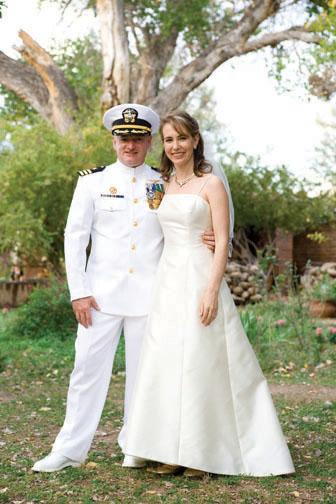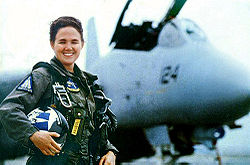09 January 2010
American Heroes

(Rep. Gabrielle Giffords and husband CDR Mark Kelly.)
Life certainly has a way of catching you off balance, doesn’t it? The authorities are attempting to sort out a brutal and senseless act of violence in Tucson, Arizona, one so unspeakable that I have a hard time contemplating the motivation.
There are nineteen wounded and killed, including a Federal Judge and a nine-year-old girl. The apparent target was three-term Congresswoman Gabrielle Giffords, a talented and articulate young woman who is married to a Naval Aviator who happens to be an Astronaut. Amid the monstrous carnage she was shot in the head at close range.
We all know more about head-wounds than we should these days. The implications are grave, and my prayers are with her.
I don’t think she would have considered going about her normal affairs an act of heroism, but it is. It reminds me of the awful days of the mid-1960s, when it seemed that each week brought news of some public figure being gunned down, and the fabric of the nation seemed to be fraying and coming apart before our eyes.
I was going to tell the story of another hero, and I will get to that in a moment. But it is time to tone down our speech, pray for those who have been so badly violated in trying to work for this Republic, and steel our resolve to move forward with civility.
God help us if we do not.
Another American hero, one who made the supreme sacrifice, was a young woman named Kara Hultgreen.
She rests over at Arlington, where I expect to be unless I am lucky enough to live past the time when the grounds are full.
The last twenty seconds of her active service passed as swiftly as the assault in Tucson.

(LT Kara Hultgreen with her F-14A. Navy Photo.)
Kara was in the cockpit of the most visible symbol of Top Gun bravado, the mighty F-14 Tomcat. For all its sleek lines, it was an old-school airplane that took a lot of sheer muscle to yank around its analogue flight controls. Kara seemed to be the answer to that problem. She could bench-press 200 pounds, and stood six-foot even in her flight boots.
She had come to the Navy via Aviation Officer Candidate School, the pressure cooker school in Pensacola that was the model for the Richard Gere film “Officer and a Gentleman.” She graduated third in her class of seven, or so the accounts go. I am sure that is higher than I placed in class 11-77, and after commissioning she was sent to NAS Corpus Christi for basic flight training.
She made the cut for jets, and was initially assigned to the electronic-warfare version of the venerable A-6 Intruder, the EA-6A Prowler. Assigned to VAQ-33 at NAS Key West, she performed Fleet support missions from the beach.
The Navy gave up its stubborn resistance to the integration of women in combat missions in 1993. The process was not swift and not pretty. The first female graduate of the Naval Academy was Elizabeth Anne Rowe who was commissioned in 1980. It took all of four more years for Kristine Holderied (USNA ‘84) to be the first woman to graduate first in her class.
The stories of their sustained performance in the face of collective harassment echoed that of others in the long history of the Academy, but the women did what they had to do.
In the wake of the collective scandals that followed the Tailhook ’91 convention in Las Vegas, the Navy opened carrier-based aviation to women for the first time. Kara was selected to be among the first female pilots to undergo F-14 Tomcat training at NAS Miramar, Fightertown, USA.
In that bastion of testosterone, Kara held her own.
You need to know about the merciless humor of Naval Aviation. It is a serious business, landing on steel decks, and must be leavened with laughter. The selection of an initial call-sign is never left up to the individual aviator; rather, it is bestowed upon one. Kara initially became “Hulk,” or “She-Hulk,” based on a play on her name and her ability to bench-press two hundred pounds.
I know a retired Vice Admiral who came out of his first fighter squadron with the call-sign “Bambi,” which he spent the next several tours trying to convert to something more martial. He eventually succeeded, as Kara would have. As a pioneer, Kara was the subject of profiles and interviews in the local press, and was part of a campaign to demonstrate that the Service had moved past the scandals of the Boys Club.
Kara made a television appearance in which she appeared to wearing make-up- something that I used to do as well when I appeared (briefly) as a news anchor on a classified DoD television station- and her squadron buddies pounced, changing her call-sign to “Revlon.”
I shudder to think what my fighter buddies would have done to me. I am not sure I could have managed the stress, but Kara did with determination and aplomb. She went through the Replacement Air Group, successfully CarQualled on USS Constellation, and was assigned to the World Famous Black Lions of VF-213 in the summer of 1994, which was working up for deployment to the Gulf to enforce sanctions against Saddam Hussein in Operation SOUTHERN WATCH.
First-time fleet aviators are known as “Nuggets,” for the gold that may be found amidst the gravel. That is what brought her out of the marshal stack and into the break in her F-14A, BuNo 160390 behind the round-down of USS Abraham Lincoln in the SoCal op area.
She was going to be right for line-up, overshooting the centerline glide slope, and she attempted to crab her way back by yawing the big airplane.
A known deficiency of the Pratt & WhitneyTF30-P-414A jet engine, notoriously underpowered for the Tomcat, was a predilection for compressor stall when inlet air pressure drops. That is what happened to Kara, who responded to the sudden asymmetric thrust of her jet by abandoning the approach and selecting Zone Five afterburner.
This action created even greater asymmetry, and with the high angle of attack induced an approach turn stall and immediate roll toward the stalled port engine.
The Guy In the Back, the Radar Intercept Officer, grabbed the lower handle and initiated the command ejection sequence. The Martin Baker seats are timed to go off .4 seconds apart. The RIO went out as the aircraft was rolling perpendicular to the water. By the time Kara’s seat fired, the Tomcat had rolled past the horizontal.
The RIO lived. Kara was ejected into the water and was killed on impact. The whole thing took less than twenty seconds.
A full recovery operation was mounted and nineteen days after the crash, the wreckage was recovered. Kara was still in her seat.
She is not the first Great American to die behind the boat. She joins hundreds of Navy pilots for whom the combination of chance and aircraft characteristics proved fatal. Carrier aviation is inherently dangerous, and completely unforgiving. Her ultimate sacrifice was in the same full measure as all aviators who have been lost at sea.
But what happened next is what was interesting in the evolution of both our little military culture, and that of the larger circus of American society.
We will have to get to that later. In the meantime, pray for the Congresswoman, the other wounded, and remember the dead and their families. By putting themselves out there to try to do the right thing they are American heroes.
Copyright 2011 Vic Socotra
vicsocotra.com | Subscribe to the RSS feed!